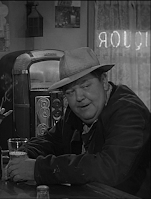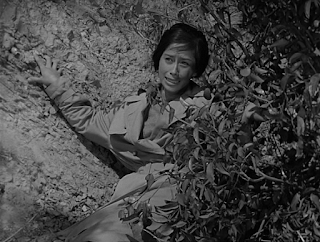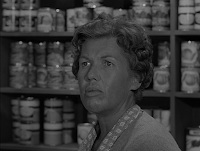by Jack Seabrook
"You'll Be the Death of Me" was adapted by William D. Gordon from "The Goldfish Button," a short story by Anthony Gilbert that was first published in the February 1958 issue of Ellery Queen's Mystery Magazine. While the story is a lovely, haunting tale that evokes the shadows that gather in the evening in the English countryside, the television version is a surprisingly effective piece of socio-political criticism that takes the story's basic elements in a new direction.
The story begins when Mary Arthur finds a button in the pocket of her husband Dendy's coat; the button is big and bright blue with a goldfish design carved on it. Mary and Dendy live together in a remote cottage in the country. The night before, Dendy had come home late after working overtime at the factory. Mary felt guilty that they argued and that he left for work in the morning before she awoke, but discovering the button turns her guilt to anger at the thought that he had been with another woman the evening before and that the button was torn from her clothing. Her terrier, Rags, causes her to spill a can of milk and so she heads out with dog and milk can to the dairy, where she learns of a murder the prior night; Bette Rose, who frequented The Blackbird, a local inn where men went to drink and play darts, was killed. She wore a bright blue coat that had big blue buttons with fish on them.
 |
| "The Goldfish Button" was first published here |
Mary thinks that she must rush home and discard the button in order to protect her husband from suspicion. Refusing an escort across the lonely moor at night, she snaps Rags's chain on his collar and heads home. When she takes an ill-advised shortcut, the dog gets caught in a thorny patch and she has to crawl under a bush to set him free. Mary arrives home to find Dendy waiting for her; she mentions the murder and asks about the button, which he claims he found on the ground and brought her as a gift. He explains that Bette Rose was strangled with her own scarf, and he found the button near the corpse.
Dendy suggests giving the button to the police but Mary tells him to throw it away, so he is not suspected of murder. Still, he insists on going to the police and she insists on going with him. They leave Rags at home and take the same shortcut that Mary had taken earlier. Suddenly, Mary asks Dendy why he failed to tell the police sergeant about the button when he was questioned that morning. Dendy distracts Mary and, when she turns, he grabs her scarf and strangles her, leaving her body on the ground in the dark for the police to find the next morning, another victim of the murderer. On his way home, he throws the button in a nest of briars. At home, Dendy recalls losing his temper and strangling Bette Rose the night before; when he came home tonight and saw the button, he knew he would have to kill Mary as well. Rags runs out the door and, later, Dendy puts the dog's chain in his pocket and sets off for the dairy to get more milk.
 |
| Robert Loggia as Driver Arthur |
An hour later, a doctor is driving by when he hears a dog barking. He investigates and finds Mary's dead body. He and his companion drive to the dairy to find a telephone and call the police, bringing the dog with them. At the dairy, Mrs. Jones recognizes Rags, assumes the corpse is that of Mary, and calls the police, who arrive right before Dendy walks in. He asks if his wife is there, claiming that she was not home when he returned from the factory. Dendy takes Rags's chain from his pocket to hook onto the dog's collar and Ruby, Mrs. Jones's daughter, realizes that Mary had the chain when she left earlier. The fact that Dendy has it now proves that he is lying about not having encountered his wife. Dendy is hanged for murder, and it is noted that his jesting remark to the dog--"'You'll Be the Death of Me'"--was prescient.
"The Goldfish Button" is a haunting story that evokes the wild English countryside in its depiction of rough folk and casual murder. It seems particularly well-suited for adaptation onto film, especially in the scenes where Mary walks through the countryside alone at night.
 |
| Pilar Seurat as Mickey Arthur |
The story's author, Anthony Gilbert, was a pseudonym of Lucy Beatrice Malleson (1899-1973), an English woman who wrote over 60 crime novels, many of which feature a lawyer named Anthony Cook. She also wrote radio plays and short stories and was active from 1935 until her death. Several films and TV shows were adapted from her stories and books; in addition to "You'll be the Death of Me," the Alfred Hitchcock Presents episode, "A True Account," was adapted from one of her short stories.
"The Goldfish Button" was collected in the 1959 book, The Lethal Sex, under the title, "You'll Be the Death of Me," and it was under this new title that it aired on The Alfred Hitchcock Hour on CBS on Friday, October 18, 1963, with a teleplay by William D. Gordon.
 |
| Sondra Kerr as Ruby McCleod |
 |
| Carmen Phillips as Bette Rose |
On his way home, Driver stops and lies down by a lake, where he is discovered by Bette Rose. The spot has meaning to her as a place where they used to spend time together, but Driver tells her that "'I'm a married man, now, Bette Rose. Can't you get that through your head?'" When Bette Rose threatens to tell Driver's wife about their past romance, he loses his temper and throttles her with her own scarf, though he says he did not mean to kill her.
 |
| G.B. Atwater as Gar Newton |
The scene then switches to the inside of Driver's home, where his wife, a young Asian woman, is alone with the dog and afraid because thunder and lightning are raging outside and her husband is late coming home from work. William D. Gordon's choice to make Driver's wife an Asian war bride is wholly unexpected and suggests that something more is going on in this adaptation than a simple translation of the story from page to screen. The show aired in 1963, a year before the U.S. sent combat troops to Vietnam, so one must assume that the wife, whose name is Mickey, is supposed to be Korean, though the Korean War had been over for a decade or so when this episode aired. Her fear at being left alone in a storm (the thunder could be reminiscent of the sounds of war from her home country and Dendy refers to the noise of the storm as "'the Lord's artillery'") takes on additional meaning due to the fact that she is a foreign woman who has been brought to an unfamiliar country and spirited off to a remote cabin, where she never sees anyone but her husband. Even her name--Mickey--is an American nickname clearly chosen to replace her real name.
 |
| Hal Smith as Tompy Dill |
 |
| Charles Seel as Dr. Chalmont |
Instead of asking Driver why he did not tell the police about the button, Mickey asks how he could have seen it on the ground the night before when there was no moonlight. Driver decides to toss the button on the ground near where he found it the night before, certain that Newton would suspect him of murder if he were to turn in the button. Her husband's actions convince Mickey that he killed Bette Rose and Driver, growing increasingly angry, picks up his wife and places her on the ground.
 |
| This particular shot seems to underline the subtext of the show. |
 |
 |
| Norman Leavitt as Kyle Sawyer |
The show is directed by Robert Douglas (1909-1999), who powerfully translates Gordon's words into pictures. Born Robert Douglas Finlayson, this Englishman was both an actor and a director on stage, film, and TV from 1927 to 1982. He flew in WWII as a Royal Navy pilot and had three distinct roles during the course of the Hitchcock TV series: he acted in two half-hour episodes (including the Hitchcock-directed "Arthur"), he directed four hour episodes (including "Behind the Locked Door"), and he produced eight episodes of the hour-long series, including the four he directed.
 |
| Kathleen Freeman as Mrs. McCleod |
This episode benefits greatly from an original score by the great Bernard Herrmann (1911-1975), who scored seven films for Hitchcock from 1955 to 1964 and who wrote original scores for 17 episodes of The Alfred Hitchcock Hour's last two seasons. (More information about Herrmann may be found here).
Robert Loggia (1930-2015) stars as Driver Arthur. Trained at the Actors Studio, he appeared on screen from 1951 to 2019, including starring in a spy series, T.H.E. Cat, during the 1966-1967 TV season. Loggia was featured in four episodes of the Hitchcock show, including "The Money."
Perfectly cast as Mickey Arthur is Pilar Seurat (1938-2001), who was born Rita Hernandez in the Philippines. She began her career as a dancer and appeared mostly on TV from 1959 to 1972, including an episode of Star Trek. This was her only appearance on the Hitchcock show.
 |
| The murder of Mickey. |
In supporting roles:
- Sondra Kerr (1936- ) makes the most of a small, non-speaking role as Ruby McCleod; she has been on screen since 1962. Born Sondra Orans, she was known as Sondra Kerr from 1961 to 1966. She was married to actor Robert Blake from 1961 to 1983 and now goes by Sondra Kerr Blake.
- G.B. Atwater (1918-1978) is suitably serious as Gar Newton, the policeman; known better as Barry Atwater, he was on screen from 1954 to 1978 and also appeared on "Thanatos Palace Hotel" on The Alfred Hitchcock Hour. Atwater played roles on The Twilight Zone, The Outer Limits, Star Trek, and Night Gallery, and he played the vampire in the TV movie, The Night Stalker (1972).
- Carmen Phillips (1937-2002) plays the thankless role of Bette Rose; on screen from 1958 to 1969, she had a bit part in Marnie (1964) and appears in five episodes of the Hitchcock series, including "The Motive," which was her first credit.
- Hal Smith (1916-1994) as Tompy Dill, who sits at the bar at The Blackbird Tavern; he was in the Air Force in WWII and played many roles on screen from 1946 to 1994. Best known as Otis the Drunk on The Andy Griffith Show, he also did quite a bit of voice work in animated films and TV shows, including the role of Owl in the Winnie the Pooh shorts.
- Charles Seel (1897-1980) plays Dr. Chalmont in the final scene at the dairy; he had a long career in vaudeville, on Broadway, and on the radio, and he was on screen from 1938 to 1976. In addition to roles on The Twilight Zone, Star Trek, and Night Gallery, he made four appearances on the Hitchcock show, including "Return of Verge Likens."
- Norman Leavitt (1913-2005) as Kyle Sawyer, who lights a cigarette for Bette Rose in The Blackbird; he was on screen from 1946 to 1978 and appeared in seven episodes of the Hitchcock show, including "One More Mile to Go."
- Kathleen Freeman (1919-2001) as Mrs. McCleod, Ruby's mother, who runs the dairy; she started out as a child in vaudeville, had a long screen career that lasted from 1948 to 2003, and did extensive work as a voice actress. She appeared on Batman and The Night Stalker, and she was on one other episode of The Alfred Hitchcock Hour.
Watch "You'll be the Death of Me" online here. Thanks to Peter Enfantino for providing a copy of "The Goldfish Button'!
Sources:
The FICTIONMAGS Index, www.philsp.com/homeville/FMI/0start.htm.
Gilbert, Anthony. "The Goldfish Button." Ellery Queen's Mystery Magazine Feb. 1958, 27-39.
Grams, Martin, and Patrik Wikstrom. The Alfred HITCHCOCK Presents Companion. OTR Pub., 2001.
IMDb, IMDb.com, www.imdb.com/.
Stephensen-Payne, Phil. "Galactic Central." Galactic Central, philsp.com/.
Wikipedia, Wikimedia Foundation, www.wikipedia.org/.
"You'll Be the Death of Me." The Alfred Hitchcock Hour, season 9, episode 4, CBS, 18 Oct. 1963.
* * * * *
William D. Gordon on The Alfred Hitchcock Hour: An Overview and Episode Guide
The six episodes of The Alfred Hitchcock Hour with teleplays either written or co-written by William D. Gordon aired between December 1962 and January 1964. Two were co-written with Alfred Hayes, one with Alec Coppel, and one with Charles Beaumont; it is speculative to try to ascertain who did what on each of those episodes. Two of the six shows were credited to Gordon alone.
"Bonfire," written with Hayes, takes a short story without a crime and transforms it into a TV show with three murders; the episode features a superb performance by Peter Falk. In "The Lonely Hours," Gordon adapts an Edgar-winning novel about an exhausted young mother and the woman who tries to steal her baby. This disturbing look at women and mothers is unusual in that it has an all-female cast. "The Long Silence," an outstanding episode written with Beaumont, improves on its source, a serialized novel, and examines a woman so traumatized that she is left bedridden and unable to speak.
"The Dark Pool," written with Coppel, deals with a mother who accidentally lets her own baby drown and who is blackmailed by a woman pretending to be the child's birth mother. "You'll Be the Death of Me" makes significant changes to its source, turning a mystery story into an allegory of the U.S. involvement in the Korean War and showing a man's casual brutality toward women. Finally, "Beyond the Sea of Death," written with Hayes, portrays a heartbroken woman who kills her older female companion after being shown that the man she loved and thought dead is alive and faithless.
These six episodes demonstrate sensitivity with stories involving female characters and domestic situations; "The Lonely Hours" and "You'll Be the Death of Me" are especially concerned with the plight of married women.
EPISODE GUIDE-WILLIAM D. GORDON ON THE ALFRED HITCHCOCK HOUR
Episode title-"Bonfire" [8.13]
Broadcast date-13 December 1962
Teleplay by-Alfred Hayes and William D. Gordon
Based on "The Wheelbarrow" by V.S. Pritchett
Episode title-"The Long Silence" [8.25]
Broadcast date-22 March 1963
Teleplay by-William D. Gordon and Charles Beaumont
Based on Composition for Four Hands by Hilda Lawrence
Broadcast date-22 March 1963
Teleplay by-William D. Gordon and Charles Beaumont
Based on Composition for Four Hands by Hilda Lawrence
Episode title-"The Dark Pool" [8.29]
Broadcast date-3 May 1963
Teleplay by-William D. Gordon and Alec Coppel
Based on unpublished story by Alec Coppel
Broadcast date-3 May 1963
Teleplay by-William D. Gordon and Alec Coppel
Based on unpublished story by Alec Coppel
Episode title-"You'll Be the Death of Me" [9.4]
Broadcast date-18 October 1963
Teleplay by-William D. Gordon
Based on "The Goldfish Button" by Anthony Gilbert
Broadcast date-18 October 1963
Teleplay by-William D. Gordon
Based on "The Goldfish Button" by Anthony Gilbert
In two weeks: Our coverage of Lewis Davidson begins with "See the Monkey Dance," starring Efrem Zimbalist Jr. and Roddy McDowall!
Listen to Al Sjoerdsma and Jack Seabrook discuss the first season of Alfred Hitchcock Presents here!

3 comments:
I don't know this one well, but it's always interesting to see Kathleen Freeman in a non-comedy role.
Thanks, Grant. She, Hal Smith, and Norman Leavitt are all familiar faces from comedy who show up in serious roles here.
Yes.
Post a Comment